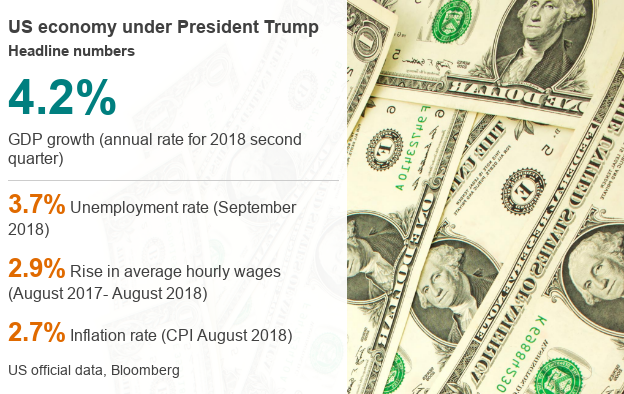Claim: President Trump says the US economy is the best it's ever been.
He has been repeating that message in the run-up to the mid-term elections in November, when voters choose members of both chambers of Congress, some state governors as well as state and local officials.
According to one estimate by the Washington Post in early September, the president had made the claim - or a variant of it - 40 times in the previous three months.
Reality Check verdict: Yes, the economy has been doing well - but there have been periods when it was even stronger.
And there are some indicators that have not really improved - such as wage growth and household income.
The growth in GDP - the value of goods and services in the economy - has been strong.
It reached an annual rate of 4.2% for the second quarter of 2018.
That's the best for several years, but less than the 4.9% achieved in the third quarter of 2014.
And there were times in the 1950s and 1960s when GDP growth was even higher.
"If you choose to look at the health of the economy based on GDP, Mr Trump's claims are suspect when compared to the national economic boom of the post-War years," says Megan Black, assistant professor of history at the London School of Economics.
"The post-War era saw tremendous economic growth, most notably in manufacturing, but also in agriculture, transportation, trade, finance, real estate and mining."
The same holds true for the rate of unemployment - another frequently used yardstick - which was measured at 3.7% in September this year.
Back in the 1950s, there were years when the unemployment rate was even lower than now.
So, the indicators currently are good - but not the best ever.
Stock market soars
President Trump has highlighted the rising value of US financial markets - in particular the Dow Jones Industrial Average, which follows the shares of 30 major US companies.It's true it has reached record highs under his administration, largely unfazed by geo-political risks such as rising trade tensions with China or President's Trump's decision last year to ditch the Trans-Pacific Partnership (TPP) trade deal.
Mr Trump's supporters argue that his corporation tax cuts along with his US-focused policies, his clampdown on bureaucracy and his promises of infrastructure investment have all helped.
Jobs and wages
So, what's happening in the broader economy with employment and wages?As we've seen, the unemployment rate now stands at 3.7% - the lowest since 1969.
It's been falling for some years - a downward trend that began during President Barack Obama's time in office.
Ryan Sweet, of Moody's Analytics. points to the changing profile of the US working population as a key factor here.
There is now a greater proportion of older workers and better educated workers, both of which tend to have lower unemployment rates.
"The labour market in 2000 had an unemployment rate below 4% - demographic changes since then would suggest the current rate should be even lower than the 3.7% seen in September," Mr Sweet says.
Mr Trump has also highlighted record low levels of African-American unemployment in particular.
He's right in that in May this year, unemployment for black Americans fell to 5.9%, the lowest figure since the 1970s.
Some US media reporting at the time highlighted some important caveats:
The figures tend to be volatile and vary from month to month
The rate is still statistically higher than for other ethnic groups
And the president's daughter, Ivanka, recently tweeted that the unemployment rate for women was at a 65-year low.
Again, that had begun to fall prior to Mr Trump taking office.
As for wages, average hourly earnings growth throughout 2017 was between 2.5% and 2.9% - continuing a generally upward trend which began during President Obama's administration.
In September this year, the increase was reported to be 2.8%.
But inflation was at 2.7% in August this year, so adjusting for that means real income growth is much less.
The other measure worth looking at is household income.
Real median household income has been growing for the past three years - but the rate of growth has slowed, according to official figures.
And in September, the US Census Bureau questioned whether its own figure for 2017 - a record high of $61,372 per annum- was that high due to differences in the way surveys had been conducted in previous years.
It's true that the fiscal stimulus, tax cuts and federal government spending rises under President Trump have helped to provide an impetus to growth - even if by some indicators, not everyone may be feeling the benefit.
Some analysts question how long the current economic trajectory can continue.
"We are experiencing a boom now but it is increasingly likely it will bust early in the next decade when the fiscal stimulus fades and the economy struggles to manage the much higher interest rates," says Mark Zandi, of Moody's Analytics.

















0 Comments:
Post a Comment